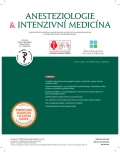Sleep endoscopy – a new challenge for the anaesthetist in the diagnostics and treatment of the obstructive sleep apnea syndrome
Authors:
O. Jor 1,2; J. Kubíčková 3,4; J. Máca 1,2; V. Šeděnková 1,2; M. Frelich 1,2; P. Ševčík 1,2; Pavel Komínek 3,4
Authors‘ workplace:
Klinika anesteziologie, resuscitace a intenzivní medicíny, Fakultní nemocnice Ostrava
1; Katedra intenzivní medicíny a forenzních oborů, Lékařská fakulta, Ostravská univerzita
2; Klinika otorinolaryngologie a chirurgie hlavy a krku, Fakultní nemocnice Ostrava
3; Katedra kraniofaciálních oborů, Lékařská fakulta, Ostravská univerzita
4
Published in:
Anest. intenziv. Med., 29, 2018, č. 2, s. 72-76
Category:
Overview
The obstructive sleep apnoea syndrome (OSA) is characterized by repeated episodes of partial or complete occlusion of the upper airways during sleep. Patients with OSA have an increased risk of hypertension, congestive heart failure, pulmonary hypertension, diabetes and stroke. OSA presents a significant risk for the general anaesthesia induction as well as the entire perioperative period. OSA is an independent risk factor for difficult bag ventilation and difficult intubation. The diagnostic problem for OSA patients is to determine the site of their airway obstruction. Local findings differ significantly in consciousness and sleep. The aim of this review article is to discuss the safest way of sedation, which at the same time imitates the natural sleep pattern and ensures maximum validity of drug-induced sleep endoscopy (DISE).
Keywords:
DISE – OSA – drug-induced sleep endoscopy
Sources
1. Peppard PE, Young T, Palta M, Skatrud J. Prospective study of the association between sleep-disordered breathing and hypertension. N Engl J Med. 2000;342:1378–1384.
2. Sharma B, Owens R, Malhotra A. Sleep in congestive heart failure. Med Clin North Am. 2010;94;447–464.
3. Kholdani C, Fares WH, Mohsenin V. Pulmonary hypertension in obstructive sleep apnea: is it clinically significant? A critical analysis of the association and pathophysiology. Pulm Circ. 2015;5;220–227.
4. Tasali E, Mokhlesi B, Van Cauter E. Obstructive sleep apnea and type 2 diabetes. Chest. 2008;133;496–506.
5. Yaggi HK,Concato J, Kernan WN, et al. Obstructive sleep apnea as a risk factor for stroke and death. N Engl J Med. 2005;353;2034–2041.
6. Hillman DR, Loadsman JA, Platt PR, Eastwood PR. Obstructive sleep apnoea and anaesthesia. Sleep Med Rev. 2004;8:459–471.
7. Herder CD. Risks of general anaesthesia in people with obstructive sleep apnoea. BMJ. 2004;329:955–959.
8. Wolfe RM, Pomerantz J, Miller DE. Obstructive sleep apnea: Preoperative screening and postoperative care. J Am Board Fam Med. 2016;29:263–275.
9. Vasu TS, Grewal R, Doghramji K. Obstructive sleep apnea syndrome and perioperative complications: a systematic review of the literature. J Clin Sleep Med. 2012;8:199–207.
10. Tregear S, Reston J, Schoelles K, Phillips B. Obstructive sleep apnea and risk of motor vehicle crash: systematic review and meta-analysis. J Clin Sleep Med. 2017;5:573–581.
11. Campanini A, Canzi P, De Vito A, et al. Awake versus sleep endoscopy: personal experience in 250 OSAHS patients. Acta Otorhinolaryngol Ital. 2010;30:73–77.
12. De Vito A, Llatas MC, Vanni A, Bosi M. European position paper on drug-induced sedation endoscopy (DISE). Sleep Breath. 2014;18:453–465.
13. Hybášková J, Jor O, Novák V, et al. Drug-induced sleep endoscopy changes the treatment concept in patients with obstructive sleep apnoea. Biomed Res Int. 2016;2016:1–5.
14. Acar HV, Yarkan Uysal H, Kaya A, et al. Does the STOP-Bang, an obstructive sleep apnea screening tool, predict difficult intubation? Eur Rev Med Pharmacol Sci. 2014;18:1869–1874.
15. Pang KP, Rotenberg BW, Tucker Woodson B (Eds). Advanced Surgical Techniques in Snoring and Obstructive Sleep Apnea. San Diego, California: Plural Publishing, 2013:43–63.
16. Shteamer JW, Dedhia RC. Sedative choice in drug-induced sleep endoscopy: A neuropharmacology-based review. Laryngoscope. 2017;127:273–279.
17. Ratnavadivel R, Chau N, Stadler D, et al. Marked reduction in obstructive sleep apnea severity in slow wave sleep. J Clin Sleep Med. 2009;5:519–524.
18. Yanovsky Y, Schubring S, Fleischer W, et al. GABAA receptors involved in sleep and anaesthesia: β1- versus β3-containing assemblies. Pflugers Arch. 2012;463:187–199.
19. Zecharia AY, Nelson LE, Gent TC, et al. The involvement of hypothalamic sleep pathways in general anesthesia: testing the hypothesis using the GABAA Receptor ?3N265M Knock-In Mouse. J Neurosci. 2009;29:2177–2187.
20. Boveroux P, Vanhaudenhuyse A, Bruno M-A, et al. Breakdown of within- and between-network resting state functional magnetic resonance imaging connectivity during Propofol-induced loss of consciousness. Anesthesiology. 2010;113:1038–1053.
21. Murphy M, Bruno M-A, Riedner BA, et al. Propofol anesthesia and sleep: a high-density EEG study. Sleep. 2011;34:283–291A.
22. De Gennaro L, Ferrara M. Sleep spindles: an overview. Sleep Med Rev. 2003;7:423–440.
23. Eastwood PR, Platt PR, Shepherd K, et al. Collapsibility of the upper airway at different concentrations of propofol anesthesia. Anesthesiology. 2005;103:470–477.
24. Zhang Z, Ferretti V, Güntan İ, et al. Neuronal ensembles sufficient for recovery sleep and the sedative actions of α2 adrenergic agonists. Nat Neurosci. 2015;18:553–561.
25. Huupponen E, Maksimow A, Lapinlampi P, et al. Electroencephalogram spindle activity during dexmedetomidine sedation and physiological sleep. Acta Anaesthesiol Scand. 2008;52:289–294.
26. Atkins JH, Mandel JE, Rosanova G. Safety and efficacy of drug-induced sleep endoscopy using a probability ramp propofol infusion system in patients with severe obstructive sleep apnea. Anesth Analg. 2014;119:805–810.
27. Wislowska, M, Giudice R, Schabus M. Searching for neuronal correlates of consciousness – what do we learn from coma and disorders of consciousness. Funct Neurol Rehabil Ergon. 2014;4:135–147.
Labels
Anaesthesiology, Resuscitation and Inten Intensive Care MedicineArticle was published in
Anaesthesiology and Intensive Care Medicine

2018 Issue 2
Most read in this issue
- The role of videolaryngoscopy in perioperative medicine
- Sleep endoscopy – a new challenge for the anaesthetist in the diagnostics and treatment of the obstructive sleep apnea syndrome
- Impact of adrenaline on the intra-arrest haemodynamics during experimental cardiac arrest
- Echocardiography accrediation for intensivists: The European Diploma in Echocardiography (EDEC)
